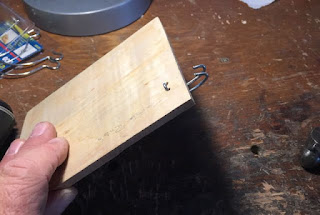I've pushed onward with the making of the Hardanger tailpiece, not one to let ignorance stop me. I'm still not sure it will work, but am basically now at the point I can try it, see what happens, and adjust. I've already made one error, but probably not a fatal one.
I wanted a bone saddle in the tailpiece, and happened to have a saddle blank of micarta, artificial bone, of about the right size among my guitar-repair supplies. I cut a groove in the tailpiece and then roughed out a similar corresponding angle on the micarta blank.
Some work with files and chisels on both maple and micarta, I managed to get it to settle in.
Then, got the top edge of the saddle down to near final, but still a little tall. I want to glue it in before finishing this step, and have a few other things to do before that.
Notice in the template, cut out from a handy piece of junk-mail, that the string grooves leading out of the holes are at an angle away from the center. I chose to ignore this, and that was an error. I'll show you why a couple of paragraphs later.
I put a couple coats of stain on the maple, to make it prettier.
So the 4 upper strings are basically handled by this. Now to make hooks under the tailpiece for the lower, or sympathetic, strings. I went to the local feed & hardware store, but they didn't have anything thin enough and also strong enough. One of these hooks will have three strings on it, and that can apply a lot of pressure to a small metal hook.
I was at a department store in town, however, and noticed these picture hangers.
Apparently the idea is that you pierce the wall with the straight end, feed it in until only the hook remains outside the wall, hang your picture there. I have no idea if they work for that, but the specs said the metal could hold 50 pounds. Kinda pricey, $7, but I was there and it was something to try. Beats driving around to other stores, at least for now.
So, I ran a trial. Cut off the hook end. Bend the remaining piece into a U, ran it through a piece of scrap maple, bent the hooks underneath. Not as tidy as I'd like, but seemed to work. I could ask an experienced Hardanger maker what sort of metal they use, and may yet, but don't like to be a pest. And, trying to figure something out often helps me understand when I later see a better solution.
So, with billowing sails, I did the same thing to the tailpiece. A bit rustic, but it's in and something to proceed with.
The error with the string grooves -- too close to the holes for the wires. I glued in some maple to fill the ends of those two middle string grooves (D & A in normal violin), and hope that keeps things from pulling through. It's all an experiment right now. Also have a couple coats of shellac on the maple and have glued in & finished the saddle.










































